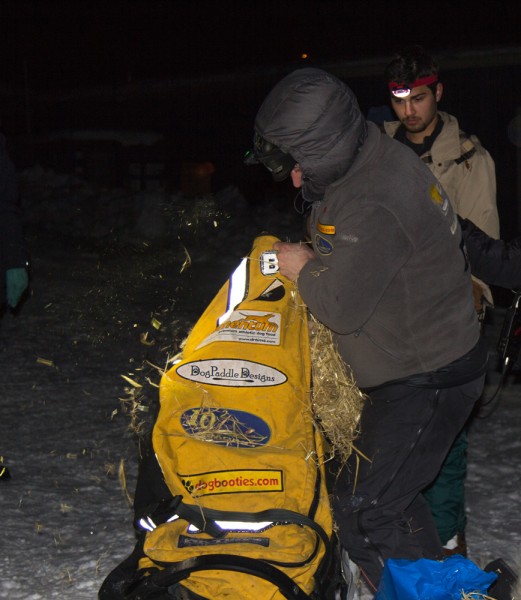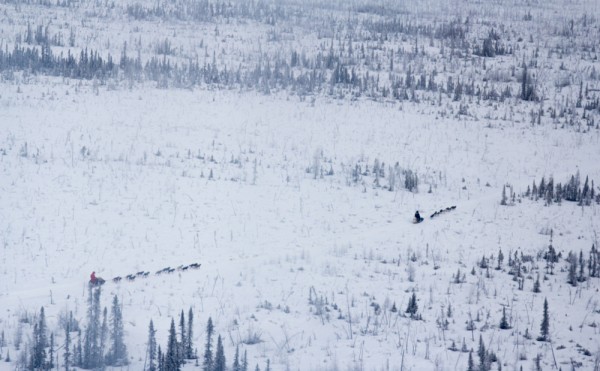
Halfway to Nome, the real racing has begun as Iditarod dog teams make their way to Ruby, the first stop along the Yukon River.
Somewhere in the next 134 miles, teams must take a mandatory eight-hour layover, but gaps are starting to open up in the field.
The challenge for mushers now is how and when they will decide to make their big moves.
Brent Sass only stayed in Ruby for nine minutes, just long enough to drop a dog.
“It’s always fun when you carry your biggest dog 30 miles,” Sass said.
The rest of the team stood patiently, tug lines tight, tails in the air as Sass rifled through two drop bags and efficiently packed his sled with food, gear and straw. He says the trail from Cripple was good.

“Kind of slow moving though,” Sass said. “With that dog in the sled, it was frustrating. The dogs are pulling good, just not moving very fast, but steady, can’t complain.”
When his sled was packed, Sass inquired briefly inquired on the whereabouts of his competition…then he pulled his snow hook and took off under the dim northern lights, the distant, blue glow from his headlamp was visible from the checkpoint after he dropped onto the Yukon River.
He camped five miles outside town. Maybe he was ready for a rest himself or perhaps he was hoping to find out whether Dallas Seavey was also planning to blow through Ruby.
In fact, Seavey opted to declare his mandatory eight-hour layover when his team arrived.
Mushers have to take the rest somewhere along the river. But Seavey wasn’t sure if he would actually follow through in Ruby.
“That’s a good question; I’m trying to figure that one out myself. Probably before we stay for that long,” Seavey said. “Yeah, I’m not sure yet, I gotta figure out what that means going forward from here.”
Seavey says he’s not concerned that an 8-hour stay would put him on a schedule that has his team running in the heat of the day. He’s also not worried about the teams around him.
“It’s still a little too early to worry at all about that,” he said. “There’s still a lot of race left to go, so I’m not going to get too fired up yet.”
He set to work lighting his cooker, pulling booties from his dogs’ paws and discussing the condition of his team with veterinarians.
As Seavey and Sass set the pace up front, a number of teams could give them a reason to look over their shoulders.
At the ceremonial start in Anchorage, Fairbanks Musher Ken Anderson was realistic about the fact that his team might be overlooked when it comes to expectations about who to watch.
“Because I’m not a big personality. I don’t like the limelight. I don’t always make the greatest media story and that’s OK,” Anderson said. “I’m just sort of a normal guy. I’m not that colorful of a character.”

But Anderson has completed the Iditarod 15 times and six of those were in the top-10. He says he has set new goals for himself based on previous experience.
“My plan is to just race with my heart instead of my head,” he said. “That’s always been an Achilles heel for me. I try to overthink things too much. Every once in a while, I kind of through that out the window and go for it and I usually do well.”
Musher Nicolas Petit has also changed his ways. The last time he drove a team on the northern route, youth and inexperience got the best of him and he was forced to scratch outside Unalakleet.
“I know what it was now. It turns out you can’t just fee ‘em rib eye steaks the whole way,” Petit said. “You can look up what a calcium efficiency does. It’s kind of scary, I’m glad I caught it in time.”
Petit is efficient in checkpoints, driven competitively and committed to a top finish, as is Wade Marrs, who says he changed his training plan in anticipation of this year’s race.
“We put on about 950 more miles this year, most of them in camping and some more early season miles,” he said.
Marrs claimed 10th place last year and the fastest run time on the final stretch to the finish line, proving his team has speed and he knows how to drive them.
But teams are only halfway to Nome.
There are still many days of racing ahead and they include more than 130 miles along the Yukon River, a tough overland route to the Bering Sea coast and a long stretch of sea ice that leads to the burled arch.




